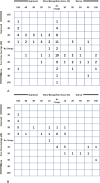Mastoid Obliteration Using S53P4 Bioactive Glass Versus Mastoidectomy Alone for Refractory Chronic Suppurative Otitis Media
- PMID: 40788269
- PMCID: PMC12379790
- DOI: 10.1097/MAO.0000000000004545
Mastoid Obliteration Using S53P4 Bioactive Glass Versus Mastoidectomy Alone for Refractory Chronic Suppurative Otitis Media
Abstract
Objective: To present the outcomes of mastoid obliteration using S53P4 bioactive glass (BAG) for refractory chronic suppurative otitis media (CSOM) and compare these to mastoidectomy alone.
Study design: Retrospective comparative cohort study.
Setting: Single-center study.
Patients: All cases that underwent a canal wall up (CWU) mastoidectomy between 2010 and 2022 for refractory CSOM. Inclusion criteria were refractory purulent otorrhea preoperatively as indicated by Merchant grade 2 or 3 despite conservative treatment for at least 6 months, at least 1 year of follow-up and mastoid involvement as indicated by subtotal or total opacification on the preoperative imaging. Patients with cholesteatoma were excluded.
Interventions: Mastoid obliteration using S53P4 BAG.
Main outcome measuress: Merchant grade 1-year postoperatively, incidence of revision surgery during follow-up, frequency of tympanic membrane perforations, ventilation tube need, and audiological outcomes.
Results: In total, 124 obliteration cases and 84 non-obliteration cases were included. At 1-year postoperatively, the dry ear rate was 116 of 124 (94%) in the obliteration cohort and 71 of 84 (85%) in the non-obliteration cohort (p = 0.02). Continuous discharge (merchant grade 3) was only observed in one non-obliteration case. During follow-up, revision surgery due to refractory otorrhea was necessary in none of the obliteration cases and 10 non-obliteration cases (p < 0.001). The frequency of tympanic membrane perforations, ventilation tube need, and audiological results were comparable between the two groups.
Conclusions: Our study indicates that for refractory cases of CSOM, mastoid obliteration using BAG results in superior outcomes compared to mastoidectomy alone. It results in significantly less postoperative otorrhea and revision operations and should therefore be considered.
Level of evidence: 3.
Keywords: Bioactive glass; Chronic suppurative otitis media; Mastoid; Obliteration; S53P4.
Copyright © 2025 The Author(s). Published by Wolters Kluwer Health, Inc. on behalf of Otology & Neurotology, Inc.
Conflict of interest statement
The authors disclose no conflicts of interest.
Figures
Similar articles
-
Aural toilet (ear cleaning) for chronic suppurative otitis media.Cochrane Database Syst Rev. 2025 Jun 9;6(6):CD013057. doi: 10.1002/14651858.CD013057.pub3. Cochrane Database Syst Rev. 2025. PMID: 40484404
-
Topical antibiotics for chronic suppurative otitis media.Cochrane Database Syst Rev. 2025 Jun 9;6(6):CD013051. doi: 10.1002/14651858.CD013051.pub3. Cochrane Database Syst Rev. 2025. PMID: 40484407
-
Topical antiseptics for chronic suppurative otitis media.Cochrane Database Syst Rev. 2025 Jun 9;6(6):CD013055. doi: 10.1002/14651858.CD013055.pub3. Cochrane Database Syst Rev. 2025. PMID: 40484403
-
Topical versus systemic antibiotics for chronic suppurative otitis media.Cochrane Database Syst Rev. 2025 Jun 9;6(6):CD013053. doi: 10.1002/14651858.CD013053.pub3. Cochrane Database Syst Rev. 2025. PMID: 40484402
-
Topical antibiotics with steroids for chronic suppurative otitis media.Cochrane Database Syst Rev. 2025 Jun 9;6(6):CD013054. doi: 10.1002/14651858.CD013054.pub3. Cochrane Database Syst Rev. 2025. PMID: 40484406
References
-
- WHO/CIBA Foundation Workshop: London, UK, World Health Organization. Programme for the Prevention of Deafness and Hearing Impairment & CIBA Foundation . Prevention of hearing impairment from chronic otitis media: report of a WHO/CIBA Foundation Workshop, London, UK, 19–21 November 1996. 1998.
-
- Verhoeff M, van der Veen EL, Rovers MM, Sanders EA, Schilder AG. Chronic suppurative otitis media: A review. Int J Pediatr Otorhinolaryngol 2006;70:1–12. - PubMed
-
- Silvola JT. Mastoidectomy cavity obliteration with bioactive glass: A pilot study. Otolaryngol Head Neck Surg 2012;147:119–26. - PubMed
Publication types
MeSH terms
Substances
LinkOut - more resources
Full Text Sources
Research Materials


